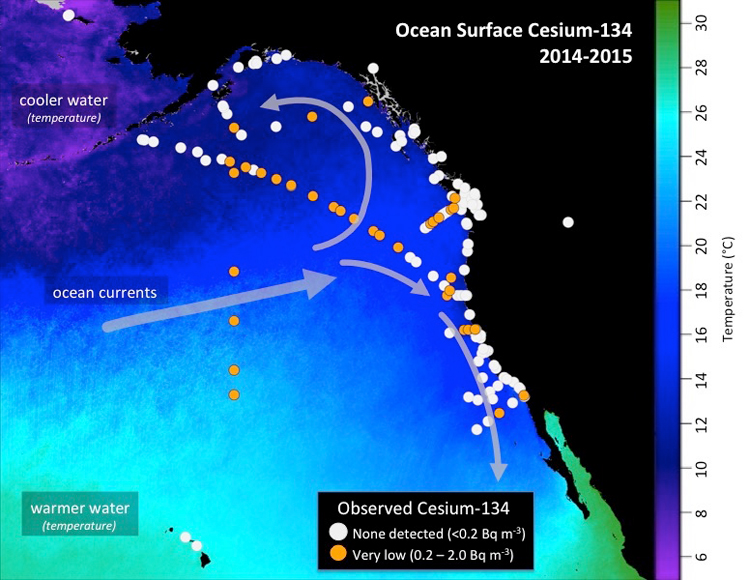Scientists detect highest levels of Fukushima radiation off the coast of California taken to date
12/07/2015 / By Greg White

Radiation from the 2011 Fukushima disaster is plaguing more and more identified sites on American shores, although research scientists continue to claim that these levels are still too low to harm marine life or the public, despite the ongoing epidemic of animal deaths in the Pacific Ocean.
The highest recorded level of radiation taken to date was discovered 1,600 miles west of San Francisco. The degree of radioactive cesium detected in water samples was 11 becquerel’s per cubic meter of seawater (264 gallons), which is 50 percent higher than other samples taken across the coast.(1)
Although this is the highest radioactive sample taken to date, it is still 500 times lower than U.S. government safety limits for drinking water, which says more about government safety standards than it does about the actual safety of the water.(1)
In fact, in response to the Fukushima disaster, the U.S. government actually chose to increase the amount of radiation that it would allow in citizens’ drinking water.
Cesium-134 and cesium-137
An increasing amount of cesium-134 has been discovered a few hundred miles from Oregon, Washington and California coasts in recent months, including offshore from Canada’s Vancouver Island. In addition, trace amounts of cesium-137 were found at low levels in almost all water samples tested by the Woods Hole Oceanographic Institution (WHOI), a nonprofit research organization.
Cesium-134 has a half-life of a little over two years, whereas cesium-137 has a half-life a little over 30 years. There was no background radioactive cesium in the environment before above-ground nuclear testing and nuclear accidents began, according to a document published on the EPA website.[PDF]

They were released into the air during all nuclear weapon tests, over 100 of which took place in the Pacific Ocean, and catastrophes, most notably by the Chernobyl disaster and the Fukushima disaster. Cesium-137 is particularly menacing and can cause burns, acute radiation sickness, cancer and even death.
Ken Buesseler, a marine radiochemist with WHOI and director of the Institution’s Center for Marine and Environmental Radioactivity, was one of the first scientists to start monitoring radiation in the Pacific Ocean. No federal agency currently keeps track of radiation levels flooding the West Coast.(1)
“These new data are important for two reasons,” said Buesseler. “First, despite the fact that the levels of contamination off our shores remain well below government-established safety limits for human health or to marine life, the changing values underscore the need to more closely monitor contamination levels across the Pacific. Second, these long-lived radioisotopes will serve as markers for years to come for scientists studying ocean currents and mixing in coastal and offshore waters.”(2)
Radiation levels off coast of Fukushima still elevated
By joining forces with Japanese colleagues, Buesseler is able to independently monitor radiation levels fueled by the Fukushima Daiichi site by collecting samples a half mile from the nuclear power plants. In October, he collected samples from ocean water, marine organisms, seafloor sediment and groundwater on the coast near the reactors.
He reports that radiation levels off the shores of Fukushima are still high, which demonstrates that officials still have no idea how to contain the disaster nearly five years after the catastrophe. Some radiation levels were 10 to 100 times higher off the shores of Fukushima than off the shores of America. Buesseler is currently working with WHOI to figure out how much radiation the Fukushima power plant is pumping into the ocean each day.
“Levels today off Japan are thousands of times lower than during the peak releases in 2011. That said, finding values that are still elevated off Fukushima confirms that there is continued release from the plant,” said Buesseler.(2)
Last year, Woods Hole found detectable radiation about 100 miles off the coast of northern California. In April, radiation was detected off the shores of Canada as well. The most recent figures confirm that the radiation plaguing North America is not bound to a few, segregated regions but stretches 1,000 miles offshore.
Buesseler is scheduled to present his most recent findings on the distribution of Fukushima radiation at the American Geophysical Union conference in San Francisco on Dec. 14, 2015.
Sources include:
(1) WHOI.edu
Submit a correction >>
Tagged Under:
Alaska, America, California, Canada, cancer, Cesium-134, Cesium-137, FukushimaWatch, North America, radiation, radioactive waste, West Coast, Woods Hole Oceanographic Institution
This article may contain statements that reflect the opinion of the author




















